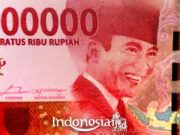Petruk is a figure of punakawan in Javanese shadow puppet art, on the part of the Witaradya lineage. Petruk is not mentioned in the Mahabharata of India. The existence of this figure in the puppet world is an original composition of the Javanese people. In the realm of Pasundan (West Java), Petruk is better known as Dawala or Udel.
According to puppetry, Petruk was the son of a giant priest in a hermitage and took place in the sea named Begawan Salantara. Previously he was named Bambang Pecruk Panyukilan. He likes to joke, both with words and in behavior and likes to fight. He is a person who chooses to compete / have magic in his residence and the surrounding area. Therefore he wanted to travel to test his strength and supernatural powers.
On the way he met Bambang Sukodadi from Bluluktiba hermitage who had left his hermitage on the hill, to test his immunity. Because it has the same purpose, then there is a fight. They fought for a very long time, punching each other, struggling, tugging, kicking, trampling, until their bodies became deformed and changed completely from their original handsome form. This fight was then separated by Smarasanta (Semar) and Bagong who accompanied Batara Ismaya. They were given advice and advice so that they finally surrendered and studied to Smara / Semar and served Sanghyang Ismaya. Thus the event is told in the Batara Ismaya Krama play.
Due to the change in form, each of them then changed their name. Bambang Pecruk Panyukilan became Petruk, while Bambang Sukodadi became Gareng.
Petruk has a wife named Dewi Ambarwati, daughter of Prabu Ambarsraya, the king of the Pandansurat State whom he got through a sparring war. The applicants included: Kalagumarang and King Kalawahana, the giant king of Guwaseluman. Petruk must face them with a battle and finally he can beat them and come out victorious. Dewi Ambarwati was then brought to Girisarangan and Resi Pariknan who assumed her marriage. In this marriage they have a son and are given the name Bambang Lengkutupuma.
In the story of Gareng Dadi Ratu, as a condition if Petruk succeeded in defeating King Pandupragolamanik (who was none other than his own brother, Nala Gareng), he asked Kresna as a reward in the form of “cemani chicks” [1]. This gift was manifested in the story of Petruk Nagih Janji, where with great difficulty he defeated Astina’s tough rival, Lesmana Mandrakumara, and also succeeded in marrying one of Kresna’s daughters, Dewi Prantawati.
Petruk is a comedian / dagelan (Javanese) character, then composed by a puppeteer a special play full of jokes and then followed by other puppeteers, so that there are a lot of plays that tell ridiculous Petruk stories, for example plays Pétruk Ilang Pethèlé (“Petruk loses his ax”), Petruk comes from the word “FAT RUK” which means leave, the word fatruk itself is taken from Arabic which means leave everything that is forbidden by Allah SWT, this name is indeed taken by Javanese poets and Sunan Kalijaga, actually punakawan was originally created by Sunan Kalijaga to spread the religion of Islam, and Bathara-bathari (gods and goddesses) here are only respected like honoring parents, not worshiped, that’s the specialty of Javanese wayang, in Islam Javanese wayang is an Islamic medium and that’s the role of the punakawan, the spreaders of Islam and in wayang also became the enduring Pandavas.
In the story of Ambangan Candi Spataharga / Saptaraga, Dewi Mustakaweni, a daughter from the country of Imantaka, managed to steal the heirloom of Jamus Kalimasada by disguising herself as a relative of the Pandavas (Gatutkaca), so that she could easily carry the heirloom away. Kalimasada then became a struggle between the two countries. In the chaos and chaos that arose, Petruk took the opportunity to hide Kalimasada, so that because of his powerful strength and influence, Petruk could become king on the throne of the Lojitengara Kingdom and had the title Prabu Welgeduwelbeh. This play is known as Petruk Dadi Ratu (“Petruk Becomes King”). King Welgeduwelbeh / Petruk with his powers was able to unlock the secrets of Prabu Pandupragola, the king of the Tracanggribig state, who was none other than his own brother, namely Nala Gareng. On the other hand, it was Bagong who deposed Prabu Welgeduwelbeh from the throne of the Lojitengara kingdom and revealed his secret to be Petruk again. Kalimasada was then returned to its original owner, Prabu Puntadewa.
Petruk and other panakawan like Semar, Gareng and Bagong always live in an atmosphere of harmony as one family. When there is no special interest, they never part from each other. Regarding Punakawan, punakawan means “friend who is watching” or companion. A witness is considered valid, if it consists of two people, it is best if the witness consists of people who are not a family. As a witness, one must be close and know something he has to witness. In puppetry, the witnesses or clerks only consist of two people, namely Semar and Bagong for the Witaradya breed.
Before Sanghyang Ismaya incarnated in his grandson named Smarasanta (Semar), except for Semar with Bagong who was created from his shadow, they then got Gareng / Bambang Sukodadi and Petruk / Bambang Panyukilan. After Batara Ismaya transformed into Janggan Smarasanta (became Semar), then Gareng and Petruk continued to join forces with Semar and Bagong. This is when there started a clown consisting of four people and then got the nickname “parepat / prapat” nana.
In the 1960s, a comic version of this punakawan character was published in Indonesia. The comic is entitled Petruk and Gareng. Actually, not only one comic artist has ever made this comic, but Indri Soedono is the comic artist who is said to have started it. Indri Soedono was the most productive comic artist who produced the Petruk and Gareng comics in the 1960s and 1970s, his works were mostly published by CV Loka Tjipta Semarang. Other comic artists who participated were Oerip, Rini A.S., Leo, Sopoiki, Tjepi, Ricky N.S., and Tatang S.
Among the comic artists who have worked on Petruk and Gareng, Tatang S is one of the most famous comic artists who made Petruk and Gareng comics because he was the one who still made these comics even though in the 1980s the world of comics in Indonesia began to fade. He made the Petruk and Gareng comics in a simple format and distributed them directly to elementary schools through children’s toy sellers. Comics with this simple format are mostly published by Gultom Agency.
The comic Petruk and Gareng that have been worked on by Indonesian comic artists is different from the original wayang story, the setting of this comic is more modern. Starting from urban communities to rural communities, complete with current attributes, namely motorbikes and cars. Hopefully this article can be useful. Come on, be a loyal reader of articles from Indonesiar.com.
Source: wikipedia































